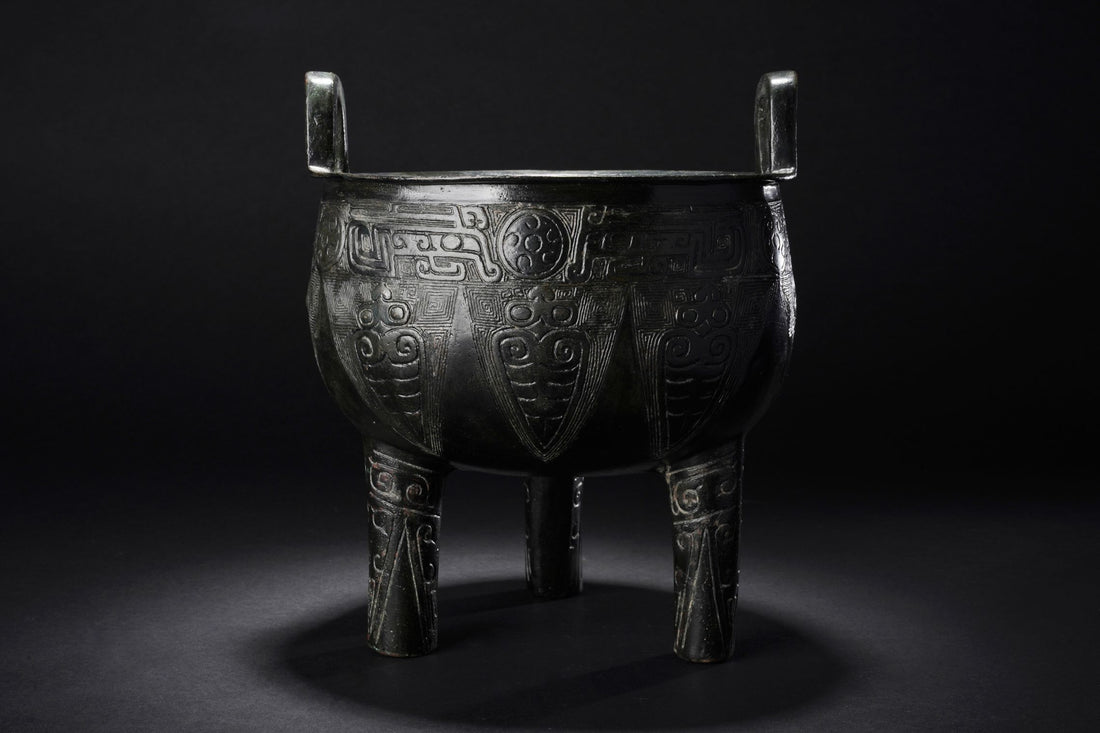
This Father's Ding Ding


This bronze tripod with cicada pattern has a round shape, two upright thick ears are symmetrically cast on the straight mouth, and three evenly distributed column-shaped feet are under the plump abdomen, reflecting the general style of thick and stable bronze wares in the Shang Dynasty. Above the belly of the tripod, a strip of decorative patterns is cast strikingly, and the motif is a very realistic and lifelike cicada. The cicadas are arranged horizontally and continuously in the same direction, with the thickness of the lines being well-proportioned and the complexity and simplicity being appropriate. Below the cicada pattern is a circle of inverted triangular patterns composed of thunder patterns, and between the two, there is a circle of continuous rolling cloud patterns on both sides, and there are also cicada patterns on the three column feet. The overall pattern of this tripod is properly dense and has clear layers. The pattern is decorated with several cicadas connected head to tail, which is what later generations called "continuous succession". There is also a word "Chan Yan", which also means to be passed down from generation to generation. Casting the "continuous succession" pattern in a conspicuous position on the bronze tripod as a treasure probably reflects the owner of the tripod's mentality of hoping that a stable and wealthy life can be passed down from generation to generation.

The cicada pattern first appeared on bronze ware in the late Shang Dynasty and was popular in the late Shang Dynasty and early Zhou Dynasty. It was mainly decorated on the belly of the tripod and the spout of the jug. After the middle of the Western Zhou Dynasty, realistic cicada patterns were rare on bronze ware, and deformed cicada patterns still appeared. The composition of the cicada pattern is very distinctive. The cicada body with hanging leaves and triangles is arranged continuously, reflecting a sense of symmetry and rhythm, full of visual impact, and complementing the overall shape of the tripod. This cicada-patterned tripod is well preserved and finely cast. It is a treasure of ancient Chinese bronze art. Similar objects to this tripod are found in: the cicada-patterned tripod of the late Shang Dynasty unearthed from Tomb No. 875 in the south of Xiaomintun, Anyang, Henan in 1982, with a total height of 23.5cm and a diameter of 17.5cm. The late Shang Dynasty tripod in the Shanghai Museum is 19.3cm high and 15.7cm in diameter, and the Shooting Girl Tripod is 25.1cm high and 20.7cm in diameter. The late Shang Dynasty triangular cicada-patterned tripod unearthed in Anyang, Henan in the Sackler Art Museum in the United States is 23.1cm high.
In addition, the inscription on the tripod is relatively simple and is very similar to the inscription No. 01595 "This Father Ding" included in the "Compendium of Bronze Inscriptions of the Yin and Zhou Dynasties" (Zhonghua Book Company, page 969), which can be used as a reference. "This Father Ding" is a "clan name + relative title + day name" structure, where "this" is the clan name. There are many bronzes with this clan name inscription, most of which are collections. In short, this tripod provides new and precious data for exploring the organizational structure, family differentiation, distribution and migration of the "this" clan in the Shang and Zhou dynasties, and the changes in the Yin and Zhou regimes. It is not only well preserved and of great historical and artistic value, but also very rare in the auction market like this tripod of large size, which is worthy of collectors' attention.
In addition, the inscription on the tripod is relatively simple and is very similar to the inscription No. 01595 "This Father Ding" included in the "Compendium of Bronze Inscriptions of the Yin and Zhou Dynasties" (Zhonghua Book Company, page 969), which can be used as a reference. "This Father Ding" is a "clan name + relative title + day name" structure, where "this" is the clan name. There are many bronzes with this clan name inscription, most of which are collections. In short, this tripod provides new and precious data for exploring the organizational structure, family differentiation, distribution and migration of the "this" clan in the Shang and Zhou dynasties, and the changes in the Yin and Zhou regimes. It is not only well preserved and of great historical and artistic value, but also very rare in the auction market like this tripod of large size, which is worthy of collectors' attention.


![8.3"China Shang Dynasty,Bronze wine cup [Fuhao Jue cup][妇好爵杯]](http://bronzc.com/cdn/shop/files/4ee0482982cfa89bb4d1cff3333a55e6_e3ca0b86-22fc-497d-9afd-578c551225a3-2.jpg?v=1733986652&width=533)

![12.8" China Ming Dynasty, Phoenix-patterned bronze vase[Ming Wanli Phoenix-patterned vase][明万历凤纹瓶]](http://bronzc.com/cdn/shop/files/4ee0482982cfa89bb4d1cff3333a55e6_a516991b-2bb9-4b2f-a2b6-4354129d006c.jpg?v=1733986953&width=533)

![14.6" China Eastern Han Dynasty Bronze vessel in the shape of a flying horse,Also known as bronze galloping horse[Horse Stepping on Flying Swallow][马踏飞燕]](http://bronzc.com/cdn/shop/files/4ee0482982cfa89bb4d1cff3333a55e6_aa3fbeb8-e08b-4a44-929a-13411ca8fb17-2.jpg?v=1733987211&width=533)

![5.9"China Tang Dynasty, Bronze of a walking dragon[Tang Walking Dragon][唐走龙]](http://bronzc.com/cdn/shop/files/2_8cb416b9-ebbd-4fe2-a905-b9277f820c16.png?v=1731488701&width=533)
